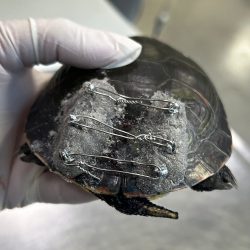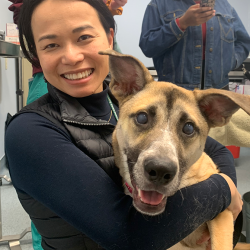While frog legs are often considered a delicacy of French cuisine for humans, they can pose a danger to our canine friends, specifically when they are consumed raw. One of these dangers comes in the form of tiny larvae of giant worms—called Dioctophyme renale—that can live in frogs. If other animals eat these frogs, they can also get infected with the parasite.

This is exactly what happened to Maverick, a nine-month-old black Labrador retriever, who was known to enjoy hunting and eating frogs. His owner, Scott Deslippe, brought Maverick to his primary veterinarian after noticing blood in his urine. Through further evaluation, the primary vet discovered substantial numbers of D. renale eggs and recommended that Deslippe take Maverick to a specialty hospital.
Deslippe brought Maverick to the MSU Veterinary Medical Center, where the Diagnostic Imaging Service performed an ultrasound. These images revealed large worms in Maverick’s right kidney, confirming that the parasite had passed from the frog to Maverick. The images also showed that the worms had caused significant destruction to the kidney, so Maverick’s care team decided to surgically remove the damaged kidney along with the worms.
Maverick was transferred to the Soft Tissue Surgery Service, where the surgical team operated on his right side and removed his kidney. Upon looking at the removed organ, the team noticed its shape was irregular, and the tissue appeared inflamed. They opened the kidney and found two adult worms inside, one male and one female. This confirmed what the ultrasound had shown—the worms had destroyed all the functional kidney tissue.
Maverick recovered quickly from the procedure and was allowed to go home a few days later. “Maverick is doing great,” says Deslippe. “He has run of our 48-acre farm and loves exploring it every day.” Deslippe is grateful to the MSU clinicians for their great care of Maverick, and advises other pet owners: “If you see blood in your dog’s urine, don’t wait to get it treated. Had we not seen the blood in the snow, we likely would not have caught this until it was too late.”
The rare case provided an educational opportunity for multiple departments at the Hospital. Isabel Greene, a licensed veterinary nurse who was present for almost every step of the diagnosis and surgery, says, “Proper diagnosis and treatment of Maverick’s kidney worm infection required the expert knowledge and skills of multiple departments of the Hospital, including Primary Care, Diagnostic Imaging, Clinical Pathology, Anesthesia, Soft Tissue Surgery, and the Intensive Care Unit. Maverick’s case truly highlights the inspiring way that the students, staff, veterinary nurses, and doctors of MSU’s Veterinary Medical Center collaborate amongst specialties to provide the highest standard of care to pets on a daily basis.”



